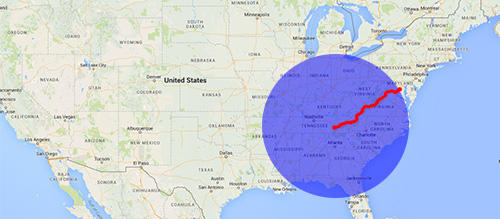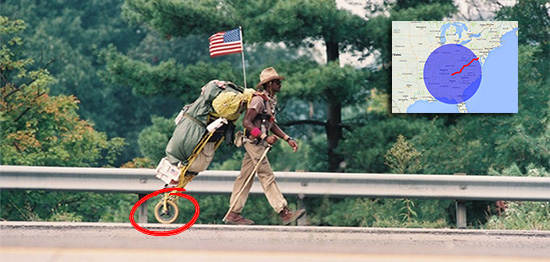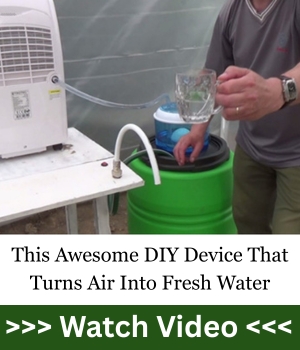On one hand, your Bug Out Bag needs to be lightweight enough so that you can move quickly and on the other hand you need to have as many supplies as possible. Keeping a good balance between those two is the key to a “smart” B.O.B.
But what if you could carry twice the weight of your B.O.B. with the same effort?
This is how the M.U.L.E was born (The Multipurpose Uniaxial Litter Enginery).
According to the company, you can “hold up to twice the weight that an average backpacker would be able to carry”.
Testing…
To further demonstrate the capabilities of the MULE, McCoy is walking 600+ miles from Knoxville, Tenn., to Washington D.C., carrying everything he needs for the journey and posts updates along the way. He walks with limited external support along secondary roads and hiking trails.
Related: How to make Hardtacks for your B.O.B.
Melvin McCoy started his 600-mile journey on July 3, at the World War I monument in downtown Knoxville.
McCoy has teamed up with Alpha Omega Veterans Services, which is a charitable organization headquartered in Memphis. Alpha Omega helps veterans reintegrate into society and has helped nearly 10,000 vets since 1987.
“Since I’ve been walking, a lot of vets have come up to express their support,” he said. “I’ve heard lots of stories from them.”
Here’s McCoy’s objective and what a 500 miles radius looks like:

My Opinion
Although I like the idea and the project, I think $600 is a lot to pay on the MULE. I mean only a few of us can afford it.
Maybe if they come up with a cheaper version, or a $40 DIY video guide… and materials that can be easily bought on the internet… I would surely do it!
For those of you, who can afford it, check out their project on Kickstarter.
You may also like:
How to Build an EMP Emergency Car Bag
H2O Dynamo – The Awesome Device That Turns Air Into Fresh Water!
This Bug Will Kill Most of the Americans during the Next Crisis. Must see! (Video)
This Common Driveway Weed is One of Nature’s Most Powerful Survival Plants























If you have seen a older person with those little carts in the grocery store pulling behind them. It could be modified to do the same as the mule?
This is actually a variation of a product that has been out there for several years, from aq european company, the name of which I cannot find at the moment, With theirs, it is supported at the waist, and the surface of the cart can be used as a table in the evening.
Dont think this one is all that old but its another option.
http://www.monowalker.com/index.html
OR…put your head into it and you can make one yourself.
Aside from the expense, the problem I see with “The Mule” is that you’ll be confined to roads or at least fairly smooth surfaces. This wouldn’t have worked on most of the hiking trails I’ve been on.
Did you watch the video? Far from being confined to smooth surfaces, this thing goes through vegetation, snow, desert terrain, rocks, and woods.
For $30 each,I bought two-wheeled, light-weight folding luggage carts, one each for myself and for my wife. They are in the car all the time. If we have to abandon the car for any reason, we can haul a lot more on the luggage cart than we can possibly carry, including water. I wouldn’t want something that I had to step into unless it was very easy to get out of very quickly. With the luggage cart I can drop it and lumber off into cover instantly. I can handle it with one hand which allows me one hand to do whatever is necessary. With two wheels it is relatively stable and can be dragged over fairly significant obstacles, yet it is narrow enough that it can be dragged down a dirt path if necessary.
If you ever read anything about the plains indians who lived a nomadic lifestyle even before they had horses, they used travois to move their shelters and all their gear when they followed the buffalo. Before they had horses, the women, children and the dogs pulled the travois. No road, no nicely groomed trails, it was over the unimproved prairie.
One section of an aluminum extension ladder would make a nice light weight travois. If one wanted to add wheels so that it pulled on paved surfaces easier, it would be simple to add an axle and wheels to it. It could be dragged behind a bicycle or pulled by a person or even a large animal.
Don’t overlook bicycles as an excellent way to move lots of gear. For those of you not old enough to remember the Ho Chi Minh Trail, the North Vietnamese gave our troops fits with the vast amount of supplies they moved down that trail during our Viet Nam follies. Thank you DDE, JFK, LBJ and RMN.
One can load panniers both front and rear on a bike and also pull a trailer. Many folks ride across the U.S. every summer with bicycles loaded with panniers and some pull trailers. If you drive down Highway 1 on the West Coast during the summer you will see many many bicyclists riding bicycles loaded fore and aft with panniers and, perhaps a back pack too. A bicyclist in good condition can easily cover 100 miles a day with a loaded bike and do it several days in a row.
In my opinion, $600 for a travois is a solution in search of a problem. There are cheaper ways to go and I certainly wouldn’t want to be strapped into something where I had to struggle to get out.
Have you been able to get the costs down, if so what would be the price now.
I recently read that there is controversy regarding the use of wheeled vehicles in national parks and some state forests. This product has come under scrutiny of the respective gov. Agencies.
Well, the Moonwalker will cost whatever the exchange rate is from 1000 Euro to US Dollars, As of 09-20-2019 that is 1,101.50. E’ll I’ll just find some old bikes somewhere and cut them up and use pipe clamps to join them together. Oh and lots of Gorilla tape- Better than Duct/duck tape. Would prefer to use Space Tape but at $200 a yard I cannot afford it.
Just use a bicycle, almost as good and you don’t need to carry anything on your back
A DIY mule Bug out bag with a wheel at bottom to take alot of the weight of the backpack *BOB w Wheel* would have to have a very lightweight wheel prehaps high strength plastic with spokes, to minimize its impact on the walker/hiker. I think I have seen some Pulleys that are plastic and big enough to fit the project… prob about $20 for the light weight pulley
Please do more free informations as we all need to help each other.
CREATE your own WATER out of the AIR humidity: ie FL is about 98% humid alot of the time in summers.. even winters are still very humid, so enter the DeHUMIDIFIER to reap the water out of the air itself, clean and distilled @ 2-4 gall /day. U will need electricity to run the dehumifier, so plan on at least 1,000w of solar panels bc gasoline may not be around for long*.
FYI: Who ever said use Coffee maker to distill: Coffe maker is NOT a distiller, but a DeHumidifier is , takes about 650 watts of power to run it and you can get “outside” in high humid environ about 2-4 gall /day… The heat in Mr coffee is not high enough to heat to evaporation temp AND condensation back to liquid water would take long time (hours).
Heat is needed to extract flavor as the water passes through the coffee in the filter, but it is just shy of enough heat to have a purifying effect on the water, so the water quality doesn’t change to a significant degree. That means you can’t count on your coffeemaker to purify water as it makes your coffee.
If in high humid state, u can also use Peltier wafers to get water by combining wafers to move the heat away from one area so water will condense and drip into a glass.. it works prepare to spend $300-$500 and build perhaps 10 modules to get perhaps 1-2 glasses of water per day best in morning when humidity is highest just be b4 dawn.
Rainwater caught in clean bowl is drinkable and pure, if off roof, let rain 10 min to cleanse, then collect in 50gal drum or other, then filter it, then boil it if drinking it.
* you might be able to use a bicycle to turn the main driveshaft of an ac or dehum unit, if accessable thus turning the compressor which should still compress the freon and still cycle the compress freon to the evaporator where it should still condense water from air,(you’ll need a make do fan to cause more air to flow to thru the evaporator thus getting more humid air, thus more water out; this is in theory if you are critically desperate. ** on the peltier solar operated system , this should be built b4 sthf day bc its hard enough as it is , but without normal working conditions it will be harder.
Buy food now, a few cans a day more for each trip to store, b sure to rotate it, buy only stuff you love to eat, beans get boring after awhile, high sugar, watery, items like mixed fruit cocktails, etc, high energy items like bacon bits, jerky, canned, that store for long times are all good.
Windmills can be good if already built and tested, even if just to pump well water up, or run small generator, we personally like the big 30 ft blades “Dutch Slow Moving Windmill” for safety as high speed blades can fly off and may wear out the gearing faster” using sail cloth to make the big vanes, you’ll need a tower about 15-20 ft diameter at bottom, tapering up about 35 ft, to accomodate the 30 ft vanes (total windmill vane diameter becomes 2 x 30 ft = ~60 ft. A top turret will turn with the balanced driveshaft holding the sail cloth vanes to get the best wind direction. Small texas style windmills can be good and they are a well known type with “Tail Rudder” to direct the vanes faces into the wind , safety: a small counter perpendicular van on the Tail Rudder will tun the windmill diagonally into wind in a high windstorm preventing overspeeding/damage/injury; other safeties can be ” centrifugal cables that turn the vanes pitch wise, or to a “feathered” mode ; these cables would go “partially” out to end of vanes and as speed picks up would pull the vanes pitch mechasim pulleys to twisting the vane so the face is with the wind so it slows to a stop). these type cables can also be used to apply brakes, We suggest for any windmill that there be 3 independent braking/slowing systems to prevent overspeeding in hurricane/storms. 1. the small perpendicular van on tail rudder, 2. Feathering the vanes 3. Brakes w yeah brake shoes or disc brakes out of junkyard? oh yes 4. The vanes can be made of lightweight PVC (sched 80? for strength) in such a way that they telescope back toward central drive shaft hub so that the total “face” into wind is brought down significantly, helping slow the overspeeding; again cables from the ends of the vanes would by centrifugal force cause the telescoping to smaller distance automatically . All these systems require no electricity, good. For the sailcloth Dutch style 5. More cables to pull in the sailcloth to the pvc vane spar so the wind would have less and less effect thus slowing the windmill overspeeding. So there you have 5 braking systems that can all be independent and give you a “SAFE” system that won’t cut you in two if high winds come up. just shy of enough heat to have a purifying effect on the water, so the water quality doesn’t change to a significant degree. That means you can’t count on your coffeemaker to purify water as it makes your coffee.
If in high humid state, u can also use Peltier wafers to get water by combining wafers to move the heat away from one area so water will condense and drip into a glass.. it works prepare to spend $300-$500 and build perhaps 10 modules to get perhaps 1-2 glasses of water per day best in morning when humidity is highest just be b4 dawn.
Rainwater caught in clean bowl is drinkable and pure, if off roof, let rain 10 min to cleanse, then collect in 50gal drum or other, then filter it, then boil it if drinking it.
I saw an article where a guy took one of those heavy duty child strollers with the big bicycle size wheels in back and a single smaller one in front. He reconfigured the seating area (this was a 2 seater) to be able to carry about 3 or 4 ties what a backpack would hold. Maybe more. This could be customized for the individual needs. Yes you have to push it but the Mule looks pretty awkward to me especially on rough terrain. Just my 2 cents. (Maybe now $5 considering how badly Biden has screwed up the economy)
Windmill safety additional “weights” on ends of cables to apply brakes, change vane pitch, telescope spars, etc …a high windstorm preventing overspeeding/damage/injury; other safeties can be ” centrifugal cables with weights on ends pull thru pulleys turn the vanes pitch wise to a feathered mode or vanes with the wind to reduce over speeding…..